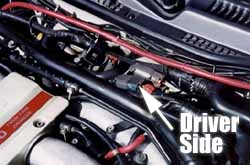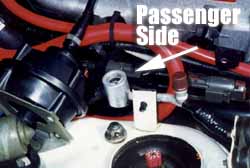Checking Oxygen Sensors:
Symptoms of bad oxygen sensors might be poor gas mileage or failing an emissions check. But there could be many other problems will also have those symptoms. Catalytic converters and oxygen sensors will not work as designed if not up to temperature. There are also adverse effects if the engine is running too rich. Running too rich can cause converters and sensors to get carbon fouled and shut down. After the rich condition is corrected, a hard run may be required to burn off the carbon and restore normal sensor/converter operation. A hard run may also be required after replacing bad sensors to clean out the converters. Cruising in a lower gear at 3000 rpm for 3 minutes should be sufficient to burn off the carbon.
O2 Sensors provide optimal engine operation during cruise by sending the ECU continuous rich/lean signals used to control the fuel injectors. This is called closed loop operation. The ECU does not directly use O2 sensor signals during idle or at wide open throttle (open loop). Here the ECU program uses fuel maps along with other sensor inputs to control mixture. However the ECU does use O2 sensor signals to adjust the fuel maps. So in theory the O2 sensors do have an indirect effect on fuel mixture during idle and WOT as well as a direct input during cruise.
Many good O2 sensors are replaced without first checking if they are still operational. Very often, sensors can last the life of the car if not damaged by contaminants. Most heated sensors will probably last at least 60,000 miles. Later versions will last over 100,000 miles. According to the service manual, an O2 sensor that is capable of providing the ECU with the proper signal (rapidly cycling between rich and lean) and has a properly functioning heater circuit does not need to be replaced. Nissan periodic maintenance does not require replacement of the oxygen sensor according to any time or mileage schedule. Those who demand optimum performance might decide to replace older sensors strictly because of age. This may or may not result in a noticeable change and may be totally unnecessary.
NOTE: Any voltage or resistance checks should be done using a high impedance digital volt-ohm meter. Using an analog meter on a Z is definitely not recommended and could possibly damage the ECU, oxygen sensor, or other sensitive electrical components. Never check resistance at the oxygen sensor center terminal (white wire). It can damage the sensor. Shorting out the sensor center terminal to ground will not damage it. Shorting it to 12 Volts will kill it.
Procedure:
1. Run ECU diagnostics. See FAQ How do I perform ECU self diagnostics? If it doesn't return code 33/53, and there are at least 5 flashes in 10 seconds with engine running at 2000 rpm for both sides, congratulations. Check the heater function for both sides to complete the sensor check. See step 4.
LED on is lean. LED off is rich. Flashing indicates constant corrections between rich and lean resulting in an optimum mixture for maximum fuel economy and minimum emissions. Note the LED at normal idle cannot be used to determine a rich or lean idle. The ECU merely retains the last condition before switching to open loop. LED on or off at idle is meaningless.
2. LED flashes of less than 5 times in ten seconds can result from a sensor damaged by contaminants (leaded gasoline or octane boosters, non-sensor safe RTV or silicone sealants, and the silica in anti-freeze). Sometimes a sensor can be carbon fouled if an engine is running too rich. Correcting the richness problem and a hard run may restore normal sensor operation. If that doesn't correct sluggishness, replace the sensor.
3. LED flashes of more than 5 times in 10 seconds indicate satisfactory sensor performance. A code 33/53 is the result of an abnormally high or low voltage signal. This could be caused by problems related to intake air leaks, fuel pressure, injectors, or harness/connector continuity. Further investigation will be required.
A bad connector or bad harness can cause a code 33/53. Cleaning connectors with tuner cleaner and applying dielectric grease is always good procedure. In more severe cases, scraping away corrosion or replacing the connector may be required. If this is suspected damage to the harness, check continuity from the center connector terminal (white wire) to the ECU harness connector, #29 right side, or #55 left side. Do this with the harness disconnected at both ends. A problem is highly unlikely but not impossible.
1. 2.
2.
4. With the connectors (1. and 2.) off, check for a resistance reading of 3 ohms to 1000 ohms on each sensor's 2 outer terminals. The oxygen sensor needs to be at the proper temp to give accurate rich/lean signal. The heater gets the sensor up to temperature quicker after a cold start. A cooler sensor runs richer.
A burned out heater element will cause the car to run rich when cold but may still give satisfactory performance under highway driving conditions. Emissions tests can still be passed if sensor is hot. Running 2000 rpm for 2 minutes will help assure the sensor is up to proper temperature. A bad heater element may not be an urgent problem. The sensor may still function normally when the engine is fully warmed up. Note a bad heater circuit will not give a code 33/53.
Check for more than 12 Volts across harness outer terminals with engine running. Black wire is ground. If OK, go to step 5. Otherwise continue. Note on later model cars, it is possible voltage may read zero with a hot engine. In other words the heater may be shut off by the ECU after the car is warmed up.
With ignition on, check harness side for 12 volts (battery voltage) at one of the outer terminals (usually it's a red wire) while using the engine as ground. Power source is from Eng Cont fuse on the left fender fuse panel. If there isn't 12V at the connector, remove the fuse. Check which fuse terminal has 12V with the ignition on. Check harness continuity between the other fuse terminal and the connector's red wire terminal.
Check for continuity (low resistance) to ground on the other outer terminal (black wire) with engine running. ECU will not provide ground to heater circuits unless engine is operating. To check the harness continuity, the ground source at the ECU is pin #115.
5. If the oxygen sensors need to be replaced, there is information on sensor removal and related pictures in the FAQ titled, How do I gut my pre-cats? When all work is completed, remember to clear codes from the ECU. Refer to How do I perform ECU self diagnostics? Select Mode II to read codes. Then select Mode I to clear codes. Select again Mode II to confirm code 55. Note turning off ignition while in Mode II will cause ECU to retain error codes in memory. Also ECU reverts to Mode I when ignition is turned off.
References:
(from '90 Service Manual)
Exhaust Gas Sensor EF&EC-12
Fuel Injection Control EF&EC-18&19
Self Diagnostic Results EF&EC-47
Self Diagnosis Mode II EF&EC-49
Diagnostic Procedure EF&EC-125
Sensor Heater Check EF&EC-178
Resetting ECU EF&EC-3
Originally posted 12-04-2001
Buzz
Photos by HawaiiZ32


